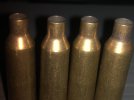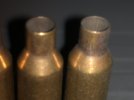You are using an out of date browser. It may not display this or other websites correctly.
You should upgrade or use an alternative browser.
You should upgrade or use an alternative browser.
Recent Experience with Peterson Brass- Neck Breakage and Brittleness
- Thread starter Veteran
- Start date
 Help Support Long Range Hunting Forum
Help Support Long Range Hunting Forum
Mikecr
Well-Known Member
Whether upsized,, downsized,, both,, it's too much sizing.
MagnumManiac
Well-Known Member
Here are some more examples of stress fracturing, this 22-250 R-P brass was new when loaded, it had been left at at my Uncles farm quite a few hours away after I moved back to the big smoke. It sat there, in a MTM 100 round box for over 8 years, all but 15 of the 48 cases fired, split the necks and none went the full length, most had 3-4 splits around the neck and all were inspected prior to shooting. So this is either age cracking, or hoop stress from sitting loaded for so long.
Here's some pics.
Cheers.
Here's some pics.
Cheers.
Attachments
simo hayha
Well-Known Member
- Joined
- Feb 7, 2016
- Messages
- 170
I would take your sizing die and hone the neck .
I also feel on some brass, annealing is a double edged sword, more harm than good.
Hone the neck, stop annealing gets my vote. Repeat.
I also feel on some brass, annealing is a double edged sword, more harm than good.
Hone the neck, stop annealing gets my vote. Repeat.
nksmfamjp
Well-Known Member
- Joined
- Jan 5, 2004
- Messages
- 3,230
Can you explain that? It makes no sense? ….I'm sure I'm just not understanding you.I also feel on some brass, annealing is a double edged sword, more harm than good.
VarmintBob
Well-Known Member
The only thing I see in your loading process that is suspect is the crimping. Annealing after every firing is the right thing to do. The only neck lubing I do is to put graphite inside the necks just before seating a bullet. I use Peterson brass for 6mm Creed. My 300 WM brass is all Winchester which is lower quality than Peterson. I've never had a 300 WM case crack at the neck. The only Peterson cases I have ever tossed were for stretched primer pockets. I suspect the crimping step is causing your premature neck failures. Are you crimping into a cannelure or just crimping a smooth bullet bearing surface? The latter is a no-no.
SSG Graybush
Well-Known Member
And looking at that brass you should be worried about case head separation as well. You should check inside of cases with a paperclip. I can see the case stretching and a line in the pic.
Please look a little closer.....what you see is the reflection of the light fixture in the brass overhead, a little bright glare spot.....it may appear to be a defect, but it is not. Case heads are all fine.And looking at that brass you should be worried about case head separation as well. You should check inside of cases with a paperclip. I can see the case stretching and a line in the pic.
They are not getting over worked.
I will have to check, but it could be a smooth surface w that seating depth on these bullets.The only thing I see in your loading process that is suspect is the crimping. Annealing after every firing is the right thing to do. The only neck lubing I do is to put graphite inside the necks just before seating a bullet. I use Peterson brass for 6mm Creed. My 300 WM brass is all Winchester which is lower quality than Peterson. I've never had a 300 WM case crack at the neck. The only Peterson cases I have ever tossed were for stretched primer pockets. I suspect the crimping step is causing your premature neck failures. Are you crimping into a cannelure or just crimping a smooth bullet bearing surface? The latter is a no-no.
I understand that crimp into a cannalure is ideal, but what is the mechanism that crimping on a smooth part of the bullet would cause split necks?
I may just stop crimping this caliber altogether unless I am using hammer bullets. Because I already have plenty of neck tension and holding friction.
SSG Graybush
Well-Known Member
No it looks bad. Take another pic. It looks like there's a low/stretch area just below the line where it will separate. Could be from before you started only bumping 2 thou, but not good.Please look a little closer.....what you see is the reflection of the light fixture in the brass overhead, a little bright glare spot.....it may appear to be a defect, but it is not. Case heads are all fine.
They are not getting over worked.
As asked before what's your fired and sized neck width?
And how are you annealing. I have a Annealleez as well, 6 to 7 seconds with the tip of the flame just touching the neck shoulder junction, is what I do. And I don't lube bullets for seating. I can get 15 firings from my 7mag Peterson brass.
QuietTexan
Well-Known Member
So to clarify you're using a 0.327" bushing? What's the thickness of the case necks?Fired O.D. of the necks is about .334 to .335 inches
I'm sizing with Redding dies using the 327 S type neck bushing.
If they're somewhat normal thickness (call it an average .0125"-ish) that sounds like too tight a bushing - do you have a .331" bushing?
I was trying to back into your neck thickness if you had loaded rounds on hand. If they aren't loaded you can measure thickness directly, which is even better.No loaded ones right now.
I just checked 3 different 300 wm fired cases with .338-.341 fired dimensions. .331 sounds tight!.. Also crimping non- cannular projectiles can Dramatically spike pressure...albeit case head separations. As stated by others....DON'T CRIMP! Back that die off!
simo hayha
Well-Known Member
- Joined
- Feb 7, 2016
- Messages
- 170
Can you explain that? It makes no sense? ….I'm sure I'm just not understanding you.
I think more brass company's will be using recycled metals, more impurities in the brass.
Not typing long-winded replies. On My phone
Ding, ding, ding! I think we have a winner!So to clarify you're using a 0.327" bushing? What's the thickness of the case necks?
If they're somewhat normal thickness (call it an average .0125"-ish) that sounds like too tight a bushing - do you have a .331" bushing?
I was trying to back into your neck thickness if you had loaded rounds on hand. If they aren't loaded you can measure thickness directly, which is even better.
That's why I asked for, but unfortunately didn't get an answer as to what the sized O.D. is. I got the dimension for a loaded round but by then the damage is done. Throw a crimp in there and it's just too much presumably since we are working with limited information. It appears to be a case of overworking the necks.

